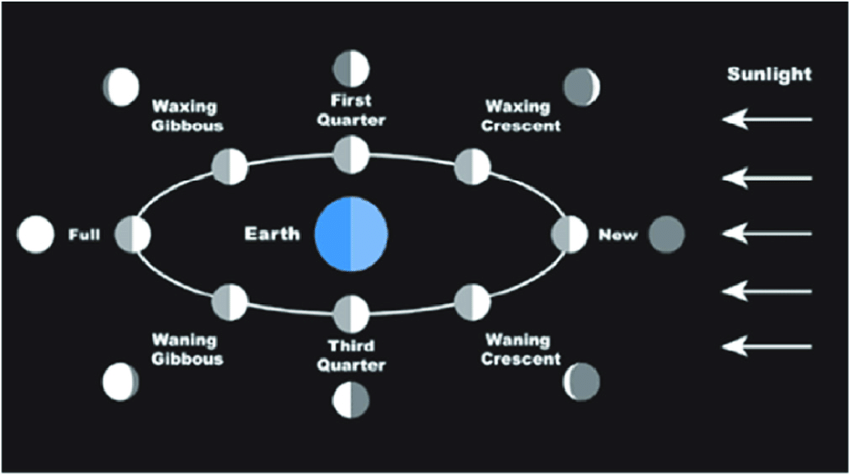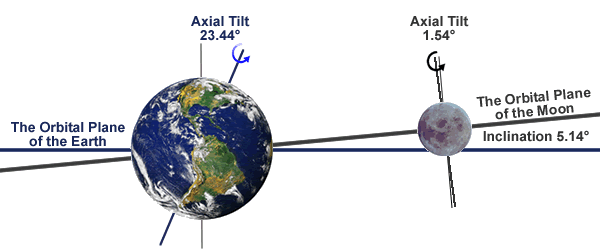70 Falmouth Street Portland, Maine 04103
43.6667° N 70.2667° W
Altitude: 10 feet below sea level
Founded January 1970
Julian Date: 245942.16
2019-2020: CXVIII
THE DAILY ASTRONOMER
Thursday, April 2, 2020
Remote Planetarium 4: A Falling and Phasing Moon
____________________________________________
TODAY'S HELPFUL REMINDER
Any object north of the celestial equator remains in the sky for more than 12 hours each day.
Any object south of the celestial equator remains in the sky for less than 12 hours each day.
____________________________________________
The moon is falling!
Yes, we mean it. The moon is falling toward Earth at this very moment, just as Earth is falling toward the Sun. In both instances, however, there is no need for concern. Both Earth and the moon are traveling along orbits around their respective parent bodies. To be in orbit is to fall around the other body high enough and fast enough so that the larger body moves out of the way before any impact can occur. To give you a clearer idea about this concept, let's play around with the cosmos a bit. (The advantage of astronomy is that one can preside over a fictional Universe to see how the parts react to different situations.)
First, we're going to release the moon from Earth's gravity. We'll retain the surface gravity to prevent our own lives from becoming too interesting. Freed from Earth's restraint, the moon starts moving along a line tangent to its orbit. Provided it encounters no impediment, the moon will continue moving along this path indefinitely. In the real world, the moon does move along a straight trajectory, but Earth's gravity nudges it slightly inward, producing the curved orbit.
Today's aim is to watch the moon, understand its motions and predict where in the sky one can find it at a given time. The best way to achieve this aim is to compile a list of moon facts, some self-evident, others quite surprising.
1. THE MOON IS ALWAYS HALF ILLUMINATED
The moon is a sphere within the range of a single light source, the Sun. As the moon revolves around Earth, one half remains illuminated while the other half is steeped in darkness. We perceive different lunar phases because our perspective on the moon changes constantly.
We define the different phases as follows:
NEW MOON (Conjunction)
The moon is between the Sun and Earth so that no part of its illuminated side faces us. 0% illuminated
WAXING CRESCENT
The moon moves through the waxing crescent phase after conjunction (new moon) but before first quadrature (first quarter). More than 0% but less than 50% illuminated.
FIRST QUARTER (First Quadrature)
We see half of the moon's lit region when the moon is at a right angle relative to the Earth-Sun line. As a rough rule of thumb, the first quarter moon rises around noon and sets around midnight. 50% illuminated
WAXING GIBBOUS
The phase between first quarter and opposition (full moon). More than 50% but less than 100% illuminated.
FULL MOON (OPPOSITION)
We see all of the moon's illuminated section at opposition. Earth is between the Sun and the moon at this time. As another rough rule of thumb, the moon rises at sunset and sets around sunrise. 100% illuminated.
WANING GIBBOUS
The phase between full moon and second quadrature (last quarter) moon. More than 50% but less than 100% illuminated
LAST QUARTER (Second quadrature)
The moon is again at right angles relative to the Sun-Earth line. We see half of its lit region. The last quarter moon rises around midnight and sets around noon. (Yes, another rule of thumb.) 50% illuminated
WANING CRESCENT
The phase between last quarter and conjunction. More than 0% but less than 50% illuminated.
2. THE MOON IS NOT ONLY VISIBLE AT NIGHT
One will see the moon in the daytime sky as often as one sees it in the night sky. We associate the moon with night because at that time the moon doesn't have to compete with the much brighter Sun for our attention. Let's examine the lunar phase list while paying close attention to the rise and set times.
The new moon rises and sets with the Sun, while the first quarter moon rises at noon and sets at midnight.
-The waxing crescent moon must then rise before noon and set before midnight. One will see the waxing crescent moon in the eastern morning and western afternoon/early evening sky. In a lunar cycle's early stage, the thin crescent moon appears along the western horizon just after sunset.
The full moon rises around sunset and sets around sunrise.
-The waxing gibbous moon rises after noon and sets after sunrise. For instance, if on a certain day the moon rises around 2 p.m, and sets around 2 a.m, it would be a waxing gibbous moon.
The last quarter moon rises around midnight and sets around noon.
-The waning gibbous moon rises after midnight and sets after noontime. As another example, if the moon rises at 3 a.m and sets around 3 p.m, it would have to be a waning gibbous moon.
[Let's brighten our day and try a few exercises. Consider this a primer for tomorrow's horrible quiz. We'll post the answers at the end of this article.
A. If the moon is 50% illuminated and rises around midnight, what is its phase?
B. If the moon is 30% illuminated and sets around 10:00 p.m, what is its phase?
C. If the moon is 15% illuminated and rises around 4 a.m. what is its phase? ]
3. THE MOON'S PATH IS ALIGNED CLOSELY WITH THE ZODIAC
Let's pretend we could see Earth's orbit about the Sun and the moon's orbit around Earth as discs. What do we see?
The moon's orbit is tilted relative to Earth's orbit (the ecliptic) by slightly more than five degrees. Consequently, we would never see the moon more than five degrees away from the ecliptic band:
Recall from yesterday that the ecliptic band passes through thirteen constellations: Pisces, Aries, Taurus, Gemini, Cancer, Leo, Virgo, Libra, Scorpius, Ophiuchus, Sagittarius, Capricornus and Aquarius. The moon would have to be in or very close to these constellations. (Note: While the Sun can only remain within one of the thirteen zodiac constellations, the planets and the moon can also occasionally veer into nearby constellation regions.)
WHERE TO SET THE MOON ALONG THE ECLIPTIC
Recall earlier that we described the moon rise/set times as rough rules of thumb. We truly meant that. If we intend to understand lunar motions, we must now see how the moon's position relative to the Sun varies through each lunar cycle.
The above star chart represents 360 degrees. Note that the point at the far right is the same as that on the far left. To represent the ecliptic more accurately, we would have to tack the two extreme points together to make a circle.
NEW MOON is 0 degrees from the Sun
FIRST QUARTER MOON is 90 degrees from the Sun
FULL MOON is 180 degrees from the Sun
LAST QUARTER MOON is 270 degrees from the Sun
Now, notice:
THE VERNAL EQUINOX position, at the far right of the star chart, is 0 degrees from the vernal equinox position. Ok, that's was pointless, but look
THE JUNE SOLSTICE position is 90 degrees from the vertical equinox position.
THE AUTUMNAL EQUINOX position is 180 degrees from the vernal equinox position.
THE DECEMBER SOLSTICE position is 270 degrees from the vernal equinox position.
We'll now go to the first day of autumn.
The Sun is on the autumnal equinox point that intersects with the celestial equator at the farthest right hand point
--If the moon were new, it would occupy the same point
--The first quarter moon would be around the June solstice point, the highest region around the ecliptic
--The full moon would be around the vernal equinox point, also along the celestial equator
--The last quarter moon would be near the December solstice point, the lowest region around the ecliptic.
Because the Sun describes the highest arc at the June solstice, the moon will also describe the highest arc when it is around the same solstice point. Conversely, the Sun moves along the lowest arc at the December solstice. When the moon occupies this part of the ecliptic, its arc will be smaller also.
---If the moon were at the first quarter point around the first day of autumn, it would travel along a high arc, rising somewhat earlier than noon and setting a little later than midnight. After all, this moon is well north of the celestial equator and remains above the horizon for more than 12 hours.
---If the moon were full around the first day of autumn, its path would be along the celestial equator. It would remain in the sky for about 12 hours and should actually rise around sunset and set at sunrise,
---If the moon were at the last quarter point around the first day of autumn, it would travel along a low arc, rising somewhat later than noon and setting earlier than midnight. This moon is south of the celestial equator and will remain in the sky for less than 12 hours.
We also note that the full moon around the June solstice occupies the December solstice region.
The full moon that occurs around the December solstice occupies the June solstice region.
CONCLUSION: Winter's first full moon follows a much higher path than summer's first full moon. When one observes the full moon in December, one should expect it to remain in the sky for quite a long time, as opposed to June's full moon which moves along a much lower arc.
On Monday, we will continue our lunar explorations.
Tomorrow, the quiz.
Also, we'd love to hear your feedback about this first week. Posting an on-line astronomy course is new territory for us, as well. How is it going so far? Too little information? Too much?
Exercise Answers
A. Last Quarter
B. Waxing Crescent
C. Waning Crescent
To subscribe or unsubscribe from the Daily Astronomer:
.jpg%22&N=Seignac,_Diane_chassant_(5613442047).jpg)


